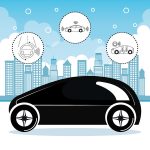1. Introduction to Artificial Intelligence in Autonomous Vehicles
Artificial Intelligence (AI) plays a crucial role in the development of autonomous vehicles. It enables self-driving cars to process vast amounts of data, make real-time decisions, and safely navigate roads without human intervention. AI technology is the backbone of modern autonomous systems, providing the intelligence needed for perception, decision-making, and control.
How AI Powers Self-Driving Cars
AI is integrated into self-driving cars through a combination of advanced computing models and sensor data interpretation. These technologies allow the vehicle to understand its environment, anticipate movements, and respond accordingly. Below are key AI-driven components in autonomous vehicles:
1. Machine Learning
Machine learning algorithms help autonomous vehicles recognize patterns in data and improve decision-making over time. By continuously learning from real-world driving scenarios, these systems become better at predicting road conditions, identifying objects, and selecting appropriate driving responses.
2. Computer Vision
Computer vision enables self-driving cars to “see” and understand their surroundings. AI-powered cameras and sensors process images and videos to identify pedestrians, traffic signs, lane markings, and other objects critical for safe driving.
3. Sensor Fusion
Autonomous vehicles rely on multiple sensors, such as LiDAR, radar, and cameras, to collect data. Sensor fusion combines information from these various sources, creating a comprehensive view of the vehicle’s environment.
| AI Technology | Function in Autonomous Vehicles |
|---|---|
| Machine Learning | Improves decision-making by identifying patterns in data |
| Computer Vision | Uses AI to process images and recognize objects |
| Sensor Fusion | Combines data from multiple sensors to enhance perception |
4. Path Planning and Control
AI helps self-driving cars determine the safest and most efficient route to their destination. Path planning algorithms consider traffic conditions, road obstacles, and real-time data to make adjustments while driving.
5. Decision-Making and Predictive Analytics
AI-powered predictive analytics allow self-driving cars to anticipate potential hazards, such as sudden stops by other vehicles or unexpected pedestrian movement. These prediction models increase safety and enhance reaction times.
Why AI is Critical for Autonomous Vehicles
Without AI, self-driving cars would not be able to function effectively. AI ensures vehicles can interpret their surroundings, make split-second decisions, and operate safely in diverse driving conditions. It is the driving force behind the development of truly autonomous and efficient transportation.
2. Machine Learning and Computer Vision
Autonomous vehicles rely on artificial intelligence (AI) technologies such as machine learning and computer vision to drive safely and effectively. These technologies allow self-driving cars to recognize objects, interpret road conditions, and make informed driving decisions in real time.
How Machine Learning Helps Autonomous Vehicles
Machine learning enables self-driving cars to learn from vast amounts of data collected from sensors, cameras, and past driving experiences. This data is used to train AI models that help the vehicle understand its surroundings and respond appropriately. The main ways machine learning contributes to autonomous driving include:
- Object Detection and Classification: Identifying pedestrians, vehicles, traffic signs, and obstacles.
- Predicting Movements: Analyzing the behavior of other road users to anticipate their next actions.
- Decision-Making: Determining the best course of action based on road conditions and traffic rules.
The Role of Computer Vision in Autonomous Vehicles
Computer vision helps self-driving cars “see” the environment by processing images and video feeds from cameras mounted on the vehicle. It works alongside machine learning to perform critical tasks such as:
- Identifying Road Signs: Recognizing speed limits, stop signs, and traffic signals.
- Lane Detection: Ensuring the vehicle stays in the correct lane and detecting lane markings.
- Obstacle Avoidance: Detecting and responding to pedestrians, cyclists, and objects on the road.
Machine Learning vs. Computer Vision
Both machine learning and computer vision are essential for autonomous driving, but they serve different purposes. The following table highlights their key differences:
| Feature | Machine Learning | Computer Vision |
|---|---|---|
| Function | Enables the car to learn from data and make decisions | Processes and interprets visual information from cameras |
| Uses | Predicting movements, decision-making, route optimization | Object recognition, lane detection, obstacle avoidance |
| Technology | Neural networks, deep learning models | Image processing, pattern recognition |
Bringing It All Together
By combining machine learning and computer vision, autonomous vehicles can navigate complex environments safely and efficiently. These technologies work together to analyze incoming data, detect objects, and make real-time driving decisions, ultimately paving the way for a future with safer and more reliable self-driving cars.

3. Sensor Fusion and Decision-Making
Autonomous vehicles rely on artificial intelligence (AI) to process data from various sensors, such as LiDAR, cameras, and radar. These sensors work together to provide a comprehensive understanding of the surrounding environment. AI combines the data from these sensors through a process called sensor fusion, allowing the vehicle to make safe and accurate real-time driving decisions.
How Sensor Fusion Works
Each sensor in an autonomous vehicle has its strengths and weaknesses. AI processes data from these sensors simultaneously to create a detailed and reliable view of the road. Heres how each sensor contributes to decision-making:
| Sensor Type | Function | Advantages | Limitations |
|---|---|---|---|
| LiDAR | Uses laser beams to create a 3D map of surroundings | Highly accurate in detecting object distances and shapes | Expensive, struggles in bad weather |
| Cameras | Capture images and videos to recognize objects, signs, and lanes | Effective in identifying colors and text | Limited performance in low light or adverse weather |
| Radar | Uses radio waves to detect object distance and speed | Works well in bad weather and detects moving objects accurately | Less precise in recognizing static objects |
Real-Time Decision-Making
AI continuously analyzes data from these sensors to make real-time driving decisions. It must determine when to stop, accelerate, or navigate obstacles. Some key AI-driven decisions include:
- Obstacle Avoidance: AI recognizes potential hazards like pedestrians and vehicles, adjusting speed or direction accordingly.
- Traffic Signal Recognition: Cameras detect traffic lights and signs, allowing the vehicle to follow traffic rules.
- Lane Keeping and Changing: AI processes lane markings and surrounding vehicles to stay in the correct lane or switch lanes safely.
- Emergency Braking: Radar and LiDAR detect sudden obstructions, triggering automatic braking to prevent accidents.
The Importance of AI in Sensor Fusion
AI plays a crucial role in interpreting sensor data accurately and making quick decisions. By combining data from multiple sources, AI ensures the vehicle can adapt to different driving conditions, enhancing safety and efficiency. Without AI-driven sensor fusion, autonomous vehicles would struggle to operate reliably in dynamic environments.
4. Challenges and Ethical Considerations
Artificial intelligence plays a crucial role in the development of autonomous vehicles, but it also comes with several challenges and ethical concerns. Issues such as system limitations, safety risks, and decision-making dilemmas need to be thoroughly examined to ensure the successful integration of self-driving technology.
Limitations of AI in Autonomous Vehicles
While AI has made significant progress in processing data and making real-time driving decisions, it is far from perfect. Several challenges limit its effectiveness:
| Limitation | Description |
|---|---|
| Weather Sensitivity | Autonomous vehicles struggle with extreme weather, such as heavy rain, snow, or fog, which interfere with sensors and cameras. |
| Complex Driving Scenarios | AI may have difficulties handling unpredictable road conditions, like sudden pedestrian movements or aggressive driving by human drivers. |
| Hardware Failures | Malfunctions in sensors, cameras, or processing units can lead to system failures, impacting overall vehicle safety. |
| Data Limitations | AI models depend on data, and insufficient or biased data can cause poor decision-making on the road. |
Safety Concerns Surrounding AI-Driven Vehicles
Safety remains one of the biggest concerns for autonomous vehicles. Although AI enables vehicles to navigate, recognize obstacles, and react to traffic conditions, accidents still occur, raising fears about reliability. Major safety concerns include:
- Decision-Making Errors: AI may misinterpret road signals, miscalculate distances, or fail to recognize hazards in certain environments.
- Cybersecurity Risks: Autonomous vehicles are vulnerable to hacking, which can lead to unauthorized control, posing serious threats to passengers and other road users.
- Human-AI Interaction: The transition from AI to human control in semi-autonomous modes can be challenging, as drivers may not react quickly enough during critical moments.
Ethical Dilemmas in AI Decision-Making
One of the most debated aspects of AI in autonomous vehicles is its ability to make ethical decisions in emergency situations. When faced with unavoidable accidents, how should AI prioritize lives? Some ethical dilemmas include:
The “Trolley Problem” in Autonomous Vehicles
The classic ethical question, known as the “Trolley Problem,” applies directly to autonomous vehicles. If a crash is imminent, should the AI prioritize minimizing casualties, protecting the passenger, or following programmed rules? Different societies may have varying perspectives on ethical driving decisions, posing challenges in global AI implementation.
Accountability and Legal Responsibility
If an autonomous vehicle causes an accident, who is responsible? Is it the manufacturer, the AI developer, the vehicle owner, or all parties involved? The lack of clear legal frameworks makes accountability difficult and can slow down the widespread adoption of self-driving technology.
Addressing These Challenges
For autonomous vehicles to become widely accepted, developers, policymakers, and society must work together to create AI-driven systems that prioritize safety, address limitations, and establish ethical guidelines for decision-making.
5. Future Trends in AI and Self-Driving Technology
Artificial intelligence (AI) continues to evolve rapidly, shaping the future of autonomous vehicles. With advancements in deep learning, sensor technology, and computing power, self-driving cars are expected to become safer, more efficient, and better integrated into everyday life. Here’s a look at some key trends in AI and autonomous driving.
Advancements in Deep Learning
Deep learning plays a crucial role in self-driving technology by enabling vehicles to analyze and interpret vast amounts of data. With improvements in neural networks, autonomous systems can more effectively recognize objects, predict behaviors, and make real-time driving decisions.
Key Deep Learning Applications
| Application | Impact on Autonomous Driving |
|---|---|
| Computer Vision | Enhances object detection and lane recognition |
| Behavior Prediction | Improves understanding of pedestrian and vehicle movements |
| Reinforcement Learning | Enables self-improving AI decision-making |
AI-Powered Decision Making
AI algorithms are becoming more sophisticated, allowing self-driving cars to process driving scenarios with higher accuracy. By integrating real-time sensor data with AI-driven decision-making, vehicles can navigate complex traffic situations more efficiently.
Enhanced Sensor Technology
Modern autonomous vehicles rely on a combination of LiDAR, cameras, and radar sensors. Future advancements in sensor technology will lead to improved accuracy, better obstacle detection, and enhanced driving performance in various environmental conditions.
Comparison of Sensor Technologies
| Sensor Type | Function | Key Benefits |
|---|---|---|
| LiDAR | 3D mapping and distance measurement | High precision in obstacle detection |
| Cameras | Visual recognition of objects and signs | Cost-effective and detailed imaging |
| Radar | Detects speed and distance | Works well in poor weather conditions |
Integration with Smart Infrastructure
As smart cities develop, self-driving cars will communicate with traffic lights, road sensors, and other vehicles. AI-driven connectivity will help improve traffic flow, reduce congestion, and enhance overall road safety.
Edge Computing and Real-Time Processing
To make autonomous driving more efficient, AI systems are shifting toward edge computing. This approach processes data locally, reducing latency and improving response time for critical driving decisions.


